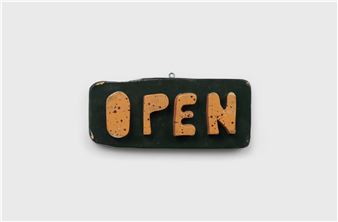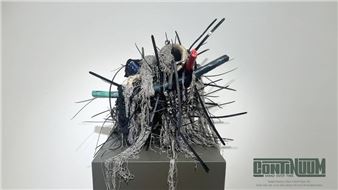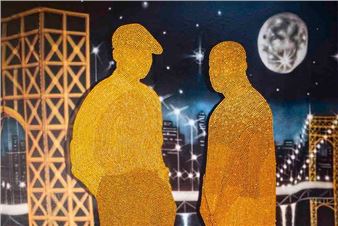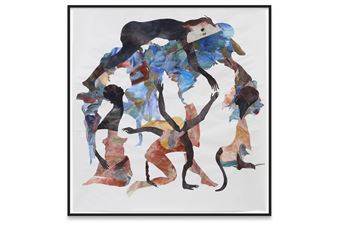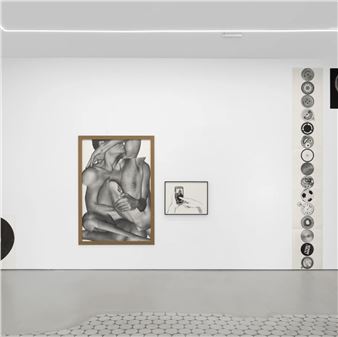Carolyn Lazard: Corpus
In their first solo exhibition at Trautwein Herleth, Carolyn Lazard examines the scribbles, blank pages, and ocular traces that shape our experiences of critical care. Focusing on the material and administrative tools that reinscribe healthcare's authorial register, the exhibition explores how medical commerce influences medical treatment. Additionally, objects used to dress medical sets in visual culture are recontextualized and rescripted - alienated from their practical use as either props or authentic artifacts. This exhibition probes medicine's representation of itself, while simultaneously reframing the visual experience of both patient and provider, gesturing toward that which can neither be described nor prescribed.
In the 1980s and 90s, there was a noticeable increase in the distribution of so-called "reminder" objects from drug makers to doctors. Beginning on January 1, 2009, the Pharmaceutical Research and Manufacturers of America (PhRMA) issued a directive to drug makers, banning giveaways of "non-educational" items, such as pens, to healthcare providers and their staffs.
In medical environments, 'positive distractions' can refer to environmental features or activities that divert patients' focus from the activity at hand. These can include artwork, soothing music, interior design and simulations of natural light.
Movies and television shows employ decommissioned medical equipment as props. Studios also craft purpose made props meant to mimic objects used in medical settings, such as patient files. Once they are no longer in use as set dressings, props of this nature can be acquired from Hollywood auction houses.
The color green is used in operating rooms to reduce visual fatigue caused by looking at red tissue and blood for extended periods of time. The practice dates back to the early 20th century when surgeons introduced green linen and decor into operating rooms, finding that their presence reduced glare and complemented the hemoglobin red, allowing for greater procedural visibility. In contemporary usage, green LED lighting is commonplace in surgical suites.
By the turn of the 20th century most European countries had replaced Gothic typefaces with Roman typefaces. In Germany, gothic typefaces continued to be used until the 1940s. In 1941 the Nazi Party mandated an end to the use of Gothic script, forbidding its use in books, periodicals and newspapers, replacing it with Roman typefaces more accessible to an audience outside of the country.
Every company in Germany is legally required to maintain functional first aid equipment. The material to be included in workplace first aid kits is mandated by the Deutsches Institut für Normung (DIN), a non-profit organization acting as national organization for standardization. Manufacturers, consumers, businesses, research institutes, public authorities and testing bodies are permitted to send experts that represent their interests to participate in the setting of DIN Standards. DIN Standards are reviewed at least every five years. If a standard no longer reflects the current state of technology, it is either revised or withdrawn.
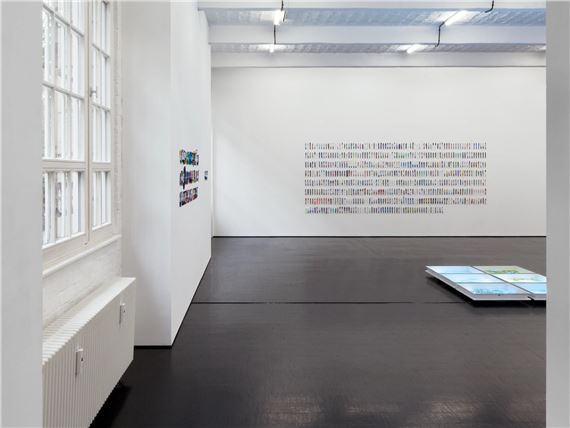
Recommended for you
In their first solo exhibition at Trautwein Herleth, Carolyn Lazard examines the scribbles, blank pages, and ocular traces that shape our experiences of critical care. Focusing on the material and administrative tools that reinscribe healthcare's authorial register, the exhibition explores how medical commerce influences medical treatment. Additionally, objects used to dress medical sets in visual culture are recontextualized and rescripted - alienated from their practical use as either props or authentic artifacts. This exhibition probes medicine's representation of itself, while simultaneously reframing the visual experience of both patient and provider, gesturing toward that which can neither be described nor prescribed.
In the 1980s and 90s, there was a noticeable increase in the distribution of so-called "reminder" objects from drug makers to doctors. Beginning on January 1, 2009, the Pharmaceutical Research and Manufacturers of America (PhRMA) issued a directive to drug makers, banning giveaways of "non-educational" items, such as pens, to healthcare providers and their staffs.
In medical environments, 'positive distractions' can refer to environmental features or activities that divert patients' focus from the activity at hand. These can include artwork, soothing music, interior design and simulations of natural light.
Movies and television shows employ decommissioned medical equipment as props. Studios also craft purpose made props meant to mimic objects used in medical settings, such as patient files. Once they are no longer in use as set dressings, props of this nature can be acquired from Hollywood auction houses.
The color green is used in operating rooms to reduce visual fatigue caused by looking at red tissue and blood for extended periods of time. The practice dates back to the early 20th century when surgeons introduced green linen and decor into operating rooms, finding that their presence reduced glare and complemented the hemoglobin red, allowing for greater procedural visibility. In contemporary usage, green LED lighting is commonplace in surgical suites.
By the turn of the 20th century most European countries had replaced Gothic typefaces with Roman typefaces. In Germany, gothic typefaces continued to be used until the 1940s. In 1941 the Nazi Party mandated an end to the use of Gothic script, forbidding its use in books, periodicals and newspapers, replacing it with Roman typefaces more accessible to an audience outside of the country.
Every company in Germany is legally required to maintain functional first aid equipment. The material to be included in workplace first aid kits is mandated by the Deutsches Institut für Normung (DIN), a non-profit organization acting as national organization for standardization. Manufacturers, consumers, businesses, research institutes, public authorities and testing bodies are permitted to send experts that represent their interests to participate in the setting of DIN Standards. DIN Standards are reviewed at least every five years. If a standard no longer reflects the current state of technology, it is either revised or withdrawn.
Artists on show
Related articles
In their first solo exhibition at Trautwein Herleth, Carolyn Lazard examines the scribbles, blank pages, and ocular traces that shape our experiences of critical care.

 ARTISTS
ARTISTS







